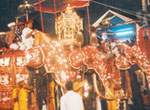|
There are four ‘devales’ in Kandy dedicated to the deities Natha, Vishnu, Kataraagma and Pattini. Since originally the Kandy Perahera began as a ‘pooja’ or offering to these deities, some of these ancient rituals are still observed. It is at a later date, exactly 250 years ago, that the Sri Dalada Maligawa joined the Esala festivities. Activities
connected with the Perahera are done at auspicious times. The ‘kap
situveema’ takes place at 5.45 in the morning on Tuesday when
the ‘kap’ is erected facing East. For four nights after
that, the Perahera will be conducted in each ‘devale’
premises with the ‘kapurala’ or the ‘devale’
priest carrying the insignia of the ‘devale’ deity.
Since the procession is held within the premises, it is called the
‘atul perahera’. When the Esala Perahera begins to parade the streets from Saturday, 2 August, each of the ‘devale’ processions as well as the main Maligawa Perahera carrying the casket will begin at an auspicious time every evening. It is a special casket decked with jewellery offered to the Sacred Tooth relic, that is taken in the Perahera. The Tooth relic is not taken out of the relic chamber. However, the thousands of devotees who flock to see the Perahera show the same devotion and respect as they would to the Tooth Relic. Customs and traditions are followed in taking out the casket from the ‘uda male’ (the upper floor) where it is kept. The Diyawadana Nilame, lay custodian of the Dalada Maligawa, accompanied by Maligawa officials walk up, opens the chamber, accepts the casket and brings it down to the entrance where the gaily decorated Maligawa tusker awaits to carry it. On the first day of the Kumbal Perahera (on Saturday), the devale processions will start at 6.52 in the evening facing North and reach the Dalada Maligawa and await the start of the Maligawa Perahera. The Maligawa Perahera will start at the auspicious time of 7.27 pm facing South and the four ‘devale peraheras’ will join it and go round the streets. Each day the times will differ, but not very much. The Kumbal Perahera (‘kumbal’ means pot) is held for five nights when the more elaborate and colourful Randoli Perahera begins. More elephants take part in the Randoli Perahera. There are also more dancers and drummers. This year the Randoli Perahera begins on Thursday, 7 August at the auspicious time of 8.39 in the evening facing North. Before that the ‘devale peraheras’ will start at 8.35 pm facing North carrying the ‘randoli’ or palanquins, which, in ancient times, have been used by the queens to get about. Each night the Perahera will take a longer route along the streets of Kandy, getting back to the Maligawa premises fairly late in the night. After the final night on Monday, 11 August, the Dalada Perahera returns to the Maligawa but after midnight (this year the auspicious time is at 1.48 am) proceeds once again to the Gedige Viharaya where, following tradition, the casket will be sealed and kept there until the next afternoon when the Day Perahera will start from there. Before dawn on Tuesday, 12 August, the devale peraheras will proceed along Peradeniya Road to the Getambe tota (ferry) for the ‘diya kapana mangallaya’ (water cutting ceremony). After the water-cutting when a new pot of water is taken from the river, the processions get back to Ganadevi Kovil in Katukelle where the customary ceremonies will be performed. The Day Perahera is due to start at 1.33 pm facing East from the Gedige Viharaya. Prior to that, the ‘devale peraheras’ will leave the Kovil at 1.03 pm. Having joined the Dalada Perahera, all processions will come through the streets of Kandy back to the Dalada Maligawa and the respective ‘devales’. The President as Head of the State will be in the President’s House to receive the Diyawadana Nilame, the Basnayaka Nilames and other officials who will report that the Esala Perahera has been successfully conducted. This is again following the traditional custom of reporting to the King at the conclusion of the Perahera. |
||||
Copyright © 2001 Wijeya Newspapers
Ltd. All rights reserved. |
 It’s
festival time in Kandy
It’s
festival time in Kandy